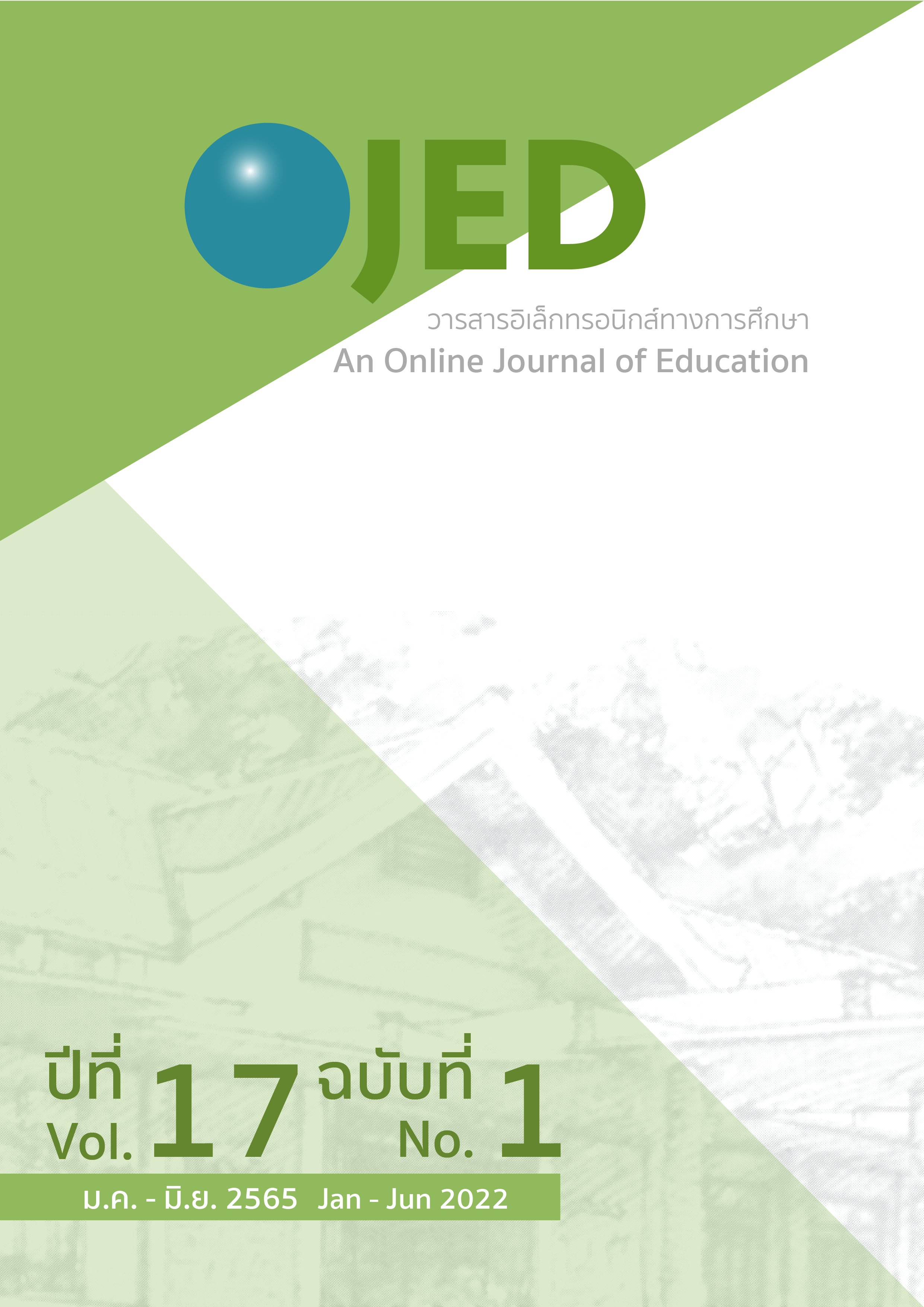Case Study: A Study of Elementary Students’ Emotional Expression in an International School
DOI:
https://doi.org/10.14456/ojed.2022.15Keywords:
emotional expression, elementary students, international schoolAbstract
This study aimed to study the factors affecting the emotional expression of fifth-grade students in an international elementary school. This qualitative study was conducted through observation of six fifth-grade students at an international elementary school. Structured observation was used to document the findings, which included the students' emotional expressions both inside and outside the classroom. The collected information was analyzed using content analysis. The results revealed that:
1) Inappropriate emotional student expressions inside the classroom occurred in multiple ways, including aggressive actions and argument. Additionally, other emotional expressions were observed, including crying, depression, silence, and cynicism. 2) Emotional expressions outside the classroom were observed when students arrived at school in the morning, during snack break, during lunch break, on the playground, and after the last class of the day. The students’ emotional expressions included resentful gestures and cynicism.
References
กรมสุขภาพจิต. (2545). คู่มือความฉลาดทางอารมณ์. ศูนย์สารนิเทศและประชาสัมพันธ์กรมสุขภาพจิต.
กฤติณภัทร สุขเจริญ, ดลพัฒน์ ยศธร และ อธิวัฒน์ เจี่ยวิวรรธน์กุล. (2561). ปัจจัยที่ส่งผลต่อพัฒนาการ และ ผลสมั ฤทธิ์ทางการเรียนวิชาพลศกึษาของนักเรียนชนั้ประถมศกึษาปีที่6: กรณีศึกษาโรงเรียนแห่งหนึ่งในจังหวัด ฉะเชิงเทรา. วารสารเกษมบัณฑิต [ฉบับพิเศษ], 19, 41-56.
เฉลิมลาภ ทองอาจ. (2556). แนวทางการแก้ไขความขัดแย้งระหว่างผู้เรียน. Oknation. http://oknation.nationtv.tv/blog/Chalermlahp/2013/03/17/entry-2
เทอดศักดิ์ เดชคง. (2542). จากความฉลาดทางอารมณ์ สู่สติและปัญญา. มติชน.
ผดุง อารยะวิญญู. (2542). เด็กที่มีปัญหาทางพฤติกรรม. แว่นแก้ว.
ศรีเรือน แก้วกังวาล. (2549). จิตวิทยาพัฒนาการชีวิตทุกช่วงวัย. สำนักพิมพ์มหาวิทยาลัยธรรมศาสตร์.
สถาบันราชานุกูล. (2558). คู่มือการดูแลเด็กวัยเรียนที่มีปัญหาพฤติกรรม-อารมณ์ สำหรับบุคลากรสาธารณสุข (ฉบับทดลองใช้). กระทรวงสาธารณสุข.
Baldry, A. C., Farrington, D. P., & Sorrentino, A. (2017). School bullying and cyberbullying among boys and girls: Roles and overlap. Journal of Aggression, Maltreatment & Trauma, 26(9), 937-951.
Basar, M., & Akan, D. (2013). Assessment of class teachers'dispute resolution applications in conflict environments on the basis of restorative justice. International Journal of Academic Research, 5(5).
Beaman, R. (2006). Behavioural interactions in the secondary school between teachers and students: What they say, what they do.
Cramer, P. (2015). Understanding defense mechanisms. Psychodynamic Psychiatry, 43(4), 523-552.
Corsano, P., Musetti, A., & Favari, D. (2020). Self-concept, loneliness, and voluntary aloneness during late childhood. Current Psychology, 1-11.
Davis, E. L., & Levine, L. J. (2013). Emotion regulation strategies that promote learning: Reappraisal enhances children’s memory for educational information. Child development, 84(1), 361-374.
Duong, J., & Bradshaw, C. P. (2017). Links between contexts and middle to late childhood social‐emotional development. American Journal of Community Psychology, 60(3-4), 538-554.
Freud, A. (1949). Notes on aggression. Bulletin of the Menninger Clinic, 13(5), 143.
Ghazi, S. R., Shahzada, G., Tariq, M., & Khan, A. Q. (2013). Types and causes of students’ disruptive behavior in classroom at secondary level in Khyber Pakhtunkhwa, Pakistan. American Journal of Educational Research, 1(9), 350-354.
Gottman, J. M. (1997). Raising an Emotional Intelligence Child. Fireside.
Greenberg, M. T., & Snell, J. L. (1997). Brain development and emotional development: The role of teaching in organizing the frontal lobe. Basic Books.
Hall, N. C., & Goetz, T. (2013). Emotion, motivation, and self-regulation: A handbook for teachers. Emerald Group.
Hamilton, F. (2020). 10 Mediation steps for resolving conflicts in student classroom. Mediate.com. https://www.mediate.com/articles/hamilton-conflict-clasroom.cfm
Kravtsova, E. E. (2009). The cultural-historical foundations of the zone of proximal development. Journal of Russian & East European Psychology, 47(6), 9-24.
Little, E., Hudson, A., & Wilks, R. (2002). The efficacy of written teacher advice (tip sheets) for managing classroom behaviour problems. Educational Psychology, 22, 251–266.
Longobardi, C., Iotti, N. O., Jungert, T., & Settanni, M. (2018). Student-teacher relationships and bullying: The role of student social status. Journal of Adolescence, 63, 1-10.
Nassem, E. (2017). The complexity of children’s involvement in school bullying. Journal of Children's Services, 12(4), 288-301. https://doi.org/10.1108/JCS-03-2017-0009
Nassem, E., & Harris, A. (2015). Why do children bully?. School Leadership Today, 6(5), 68-73.
Rivera, D. (2015). Let the child cry: How tears support social and emotional development. edutopia. https://www.edutopia.org/blog/tears-support-social-emotional-development-diana-rivera
Salman, S., & Salem, M. L. (2020). Routine childhood immunization may protect against COVID-19. Medical Hypotheses, 140, 109689.
Schick, A., & Cierpka, M. (2005). Faustlos: Evaluation of a curriculum to prevent violence in elementary schools. Applied and Preventive Psychology, 11(3), 157-165.
Shore, K. (2003). Elementary teacher's discipline problem solver: a practical AZ guide for managing classroom behavior problems. Jossey-Bass.
Stephenson, J., Linfoot, K., & Martin, A.J. (2000). Behaviours of concern to teachers in the early years of school. International Journal of Disability, Development and Education, 47, 225–235.
Tingley, S. C. (2020). Dealing with conflicts in school: Advice from a former principal. Hey Teacher. https://www.wgu.edu/heyteach/article/dealing-teacher-conflicts-school-advice-former-principal1710.html
Webster-Stratton, C., & Reid, M. J. (2004). Strengthening social and emotional competence in young children—The foundation for early school readiness and success: Incredible years classroom social skills and problem-solving curriculum. Infants & Young Children, 17(2), 96-113.
Weyns, T., Colpin, H., De Laet, S., Engels, M., & Verschueren, K. (2018). Teacher support, peer acceptance, and engagement in the classroom: A three-wave longitudinal study in late childhood. Journal of Youth and Adolescence, 47(6), 1139-1150.
Wheldall, K. (1991). Managing troublesome classroom behaviour in regular schools: A positive teaching perspective. International Journal of Disability, Development and Education, 38, 99–116.
World Health Organization. (1994). Life skills education for children and adolescents in schools. Pt. 3, Training workshops for the development and implementation of life skills programmes (No. WHO/MNH/PSF/93.7 B. Rev. 1). World Health Organization.
Zuffianò, A., López-Pérez, B., Cirimele, F., Kvapilová, J., & Caprara, G. V. (2019). The positivity scale: Concurrent and factorial validity across late childhood and early adolescence. Frontiers in Psychology, 10, 831.
Downloads
Published
How to Cite
Issue
Section
License
Copyright (c) 2022 An Online Journal of Education

This work is licensed under a Creative Commons Attribution-NonCommercial-NoDerivatives 4.0 International License.




